[1]:
%matplotlib inline
D:\C\Anaconda3\envs\tfcpu27_py39\lib\site-packages\numpy\_distributor_init.py:30: UserWarning: loaded more than 1 DLL from .libs:
D:\C\Anaconda3\envs\tfcpu27_py39\lib\site-packages\numpy\.libs\libopenblas.EL2C6PLE4ZYW3ECEVIV3OXXGRN2NRFM2.gfortran-win_amd64.dll
D:\C\Anaconda3\envs\tfcpu27_py39\lib\site-packages\numpy\.libs\libopenblas.GK7GX5KEQ4F6UYO3P26ULGBQYHGQO7J4.gfortran-win_amd64.dll
warnings.warn("loaded more than 1 DLL from .libs:"
[ ]:
try:
import ai4water
except (ImportError, ModuleNotFoundError):
!pip install ai4water[tf_hpo]
HyperOpt for neural networks
This file shows how to optimize number of layers, neurons/units/filters in layers and activation functions of layers using HyperOpt class of AI4Water. The HyperOpt class provides a lower level API for hyperparameter optimization. It provides more control to the user. However, the user has to write the objective function, define parameter space and initial values itself.
[33]:
import os
import math
from typing import Union
import numpy as np
from skopt.plots import plot_objective
from SeqMetrics import RegressionMetrics
from ai4water import Model
from ai4water.models import MLP
from ai4water.utils import TrainTestSplit
from ai4water.preprocessing import DataSet
from ai4water.datasets import mg_photodegradation
from ai4water.utils.utils import get_version_info
from ai4water.utils.utils import jsonize, dateandtime_now
from ai4water.hyperopt import HyperOpt, Categorical, Real, Integer
[3]:
for k,v in get_version_info().items():
print(f"{k} version: {v}")
python version: 3.9.7 | packaged by conda-forge | (default, Sep 29 2021, 19:20:16) [MSC v.1916 64 bit (AMD64)]
os version: nt
ai4water version: 1.06
lightgbm version: 3.3.1
tcn version: 3.4.0
catboost version: 0.26
xgboost version: 1.5.0
easy_mpl version: 0.21.3
SeqMetrics version: 1.3.3
tensorflow version: 2.7.0
keras.api._v2.keras version: 2.7.0
numpy version: 1.21.0
pandas version: 1.3.4
matplotlib version: 3.4.3
h5py version: 3.5.0
sklearn version: 1.0.1
shapefile version: 2.3.0
xarray version: 0.20.1
netCDF4 version: 1.5.7
optuna version: 2.10.1
skopt version: 0.9.0
hyperopt version: 0.2.7
plotly version: 5.3.1
lime version: NotDefined
seaborn version: 0.11.2
[4]:
data, *_ = mg_photodegradation(encoding="le")
data.shape
[4]:
(1200, 12)
[5]:
data.head()
[5]:
| Surface area | Pore Volume | Catalyst_loading (g/L) | Light_intensity (W) | time (min) | solution_pH | HA (mg/L) | Ci (mg/L) | Cf (mg/L) | Catalyst_type | Anions | Efficiency (%) | |
|---|---|---|---|---|---|---|---|---|---|---|---|---|
| 0 | 0.0 | 0.0 | 0.0 | 105 | 0 | 5.45 | 0 | 10 | 10.00 | 13 | 5 | 0.0 |
| 1 | 0.0 | 0.0 | 0.0 | 105 | 30 | 5.45 | 0 | 10 | 9.98 | 13 | 5 | 0.2 |
| 2 | 0.0 | 0.0 | 0.0 | 105 | 60 | 5.45 | 0 | 10 | 9.96 | 13 | 5 | 0.4 |
| 3 | 0.0 | 0.0 | 0.0 | 105 | 90 | 5.45 | 0 | 10 | 9.94 | 13 | 5 | 0.6 |
| 4 | 0.0 | 0.0 | 0.0 | 105 | 120 | 5.45 | 0 | 10 | 9.87 | 13 | 5 | 1.3 |
[6]:
input_features = data.columns.tolist()[0:-1]
print(input_features)
['Surface area', 'Pore Volume', 'Catalyst_loading (g/L)', 'Light_intensity (W)', 'time (min)', 'solution_pH', 'HA (mg/L)', 'Ci (mg/L)', 'Cf (mg/L)', 'Catalyst_type', 'Anions']
[7]:
output_features = data.columns.tolist()[-1:]
print(output_features)
['Efficiency (%)']
[8]:
ds = DataSet(
data=data,
input_features=input_features,
output_features=output_features,
val_fraction = 0.0
)
TrainX, TrainY = ds.training_data()
***** Training *****
input_x shape: (840, 11)
target shape: (840, 1)
[9]:
TestX, TestY = ds.test_data()
***** Test *****
input_x shape: (360, 11)
target shape: (360, 1)
1) Check model performance with default hyperparameters
[10]:
model = Model(
model=MLP(),
input_features=input_features,
output_features=output_features,
epochs=100
)
building DL model for
regression problem using Model
Model: "model"
_________________________________________________________________
Layer (type) Output Shape Param #
=================================================================
input_1 (InputLayer) [(None, 11)] 0
Dense_0 (Dense) (None, 32) 384
Flatten (Flatten) (None, 32) 0
Dense_out (Dense) (None, 1) 33
=================================================================
Total params: 417
Trainable params: 417
Non-trainable params: 0
_________________________________________________________________
[11]:
h = model.fit(x=TrainX, y=TrainY, verbose=0)
assigning name input_1 to IteratorGetNext:0 with shape (None, 11)
assigning name input_1 to IteratorGetNext:0 with shape (None, 11)
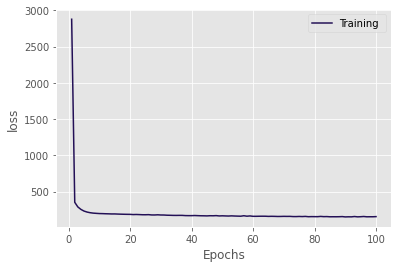
********** Successfully loaded weights from weights_090_150.56535.hdf5 file **********
[12]:
model.evaluate(x=TrainX, y=TrainY, metrics=['r2', 'nse', 'rmse'])
assigning name input_1 to IteratorGetNext:0 with shape (None, 11)
27/27 [==============================] - 0s 462us/step
[12]:
{'r2': 0.8287747129910914,
'nse': 0.8242104533788417,
'rmse': 12.395706486756165}
[13]:
model.evaluate(x=TestX, y=TestY, metrics=['r2', 'nse', 'rmse'])
12/12 [==============================] - 0s 545us/step
[13]:
{'r2': 0.7797056476775908,
'nse': 0.6953130002838437,
'rmse': 19.062730432656256}
[14]:
spliter = TrainTestSplit()
train_x, val_x, train_y, val_y = spliter.split_by_slicing(TrainX, TrainY)
train_x.shape, val_x.shape, train_y.shape, val_y.shape
[14]:
((588, 11), (252, 11), (588, 1), (252, 1))
[16]:
SUGGESTIONS = {}
It is always a good practice to monitor more than 1 performance metric, even though our objective function will not be based upon these performance metrics.
[17]:
MONITOR = {"rmse": [], "nse": [], "r2": [], "pbias": [], "nrmse": []}
2) define objective function
[18]:
def objective_fn(
prefix: str = None,
return_model: bool = False,
fit_on_all_training_data:bool = False,
epochs:int = 100,
verbosity: int = 0,
**suggestions
)->Union[float, Model]:
"""
This function must build, train and evaluate the ML model.
The output of this function will be minimized by optimization algorithm.
In this example we are considering same number of units and same activation for each
layer. If we want to have (optimize) different number of units for each layer,
willhave to modify the parameter space accordingly. The LSTM function
can be used to have separate number of units and activation function for each layer.
Parameters
----------
prefix : str
prefix to save the results. This argument will only be used after
the optimization is complete
return_model : bool, optional (default=False)
if True, then objective function will return the built model. This
argument will only be used after the optimization is complete
epochs : int, optional
the number of epochs for which to train the model
verbosity : int, optional (default=1)
determines the amount of information to be printed
fit_on_all_training_data : bool, optional
Whether to predict on all the training data (training+validation)
or to training on only training data and evaluate on validation data.
During hpo iterations, we will train the model on training data
and evaluate on validation data. After hpo, we the model is
trained on allt he training data and evaluated on test data.
suggestions : dict
a dictionary with values of hyperparameters at the iteration when
this objective function is called. The objective function will be
called as many times as the number of iterations in optimization
algorithm.
Returns
-------
float or Model
"""
suggestions = jsonize(suggestions)
global ITER
# i) build model
_model = Model(
model=MLP(units=suggestions['units'],
num_layers=suggestions['num_layers'],
activation=suggestions['activation'],
dropout=0.2),
batch_size=suggestions["batch_size"],
lr=suggestions["lr"],
prefix=prefix or PREFIX,
epochs=epochs,
input_features=data.columns.tolist()[0:-1],
output_features=data.columns.tolist()[-1:],
verbosity=verbosity)
SUGGESTIONS[ITER] = suggestions
# ii) train model
if fit_on_all_training_data:
_model.fit(x=TrainX, y=TrainY, validation_data=(TestX, TestY), verbose=0)
prediction = _model.predict(x=TestX)
true = TestY
else:
_model.fit(x=train_x, y=train_y, validation_data=(val_x, val_y), verbose=0)
prediction = _model.predict(x=val_x)
true = val_y
# iii) evaluate model
metrics = RegressionMetrics(true, prediction)
val_score = metrics.rmse()
for metric in MONITOR.keys():
val = getattr(metrics, metric)()
MONITOR[metric].append(val)
# here we are evaluating model with respect to mse, therefore
# we don't need to subtract it from 1.0
if not math.isfinite(val_score):
val_score = 9999
best_score = round(np.nanmin(MONITOR['rmse']), 2)
best_iter = np.argmin(MONITOR['rmse'])
print(f"{ITER} {round(val_score, 2)} . Best was {best_score} at {best_iter}")
ITER += 1
if return_model:
return _model
return val_score
3) define parameter space
parameter space
[19]:
param_space = [
Integer(10, 30, name="units"),
Integer(1, 2, name="num_layers"),
Categorical(["relu", "elu", "tanh"], name="activation"),
Real(0.00001, 0.01, name="lr"),
Categorical([4, 8, 12, 16, 24], name="batch_size")
]
4) initial state
initial values
[20]:
x0 = [14, 1, "relu", 0.001, 8]
5) run optimization algorithm
initialize the HyperOpt class and call fit method on it
[21]:
optimizer = HyperOpt(
algorithm="bayes",
objective_fn=objective_fn,
param_space=param_space,
x0=x0,
num_iterations=num_iterations,
process_results=False, # we can turn it False if we want post-processing of results
opt_path=f"results{SEP}{PREFIX}"
)
assigning name input_1 to IteratorGetNext:0 with shape (None, 11)
assigning name input_1 to IteratorGetNext:0 with shape (None, 11)
assigning name input_1 to IteratorGetNext:0 with shape (None, 11)
assigning name input_1 to IteratorGetNext:0 with shape (None, 11)
0 11.42 . Best was 11.42 at 0
assigning name input_1 to IteratorGetNext:0 with shape (None, 11)
assigning name input_1 to IteratorGetNext:0 with shape (None, 11)
assigning name input_1 to IteratorGetNext:0 with shape (None, 11)
assigning name input_1 to IteratorGetNext:0 with shape (None, 11)
1 17.02 . Best was 11.42 at 0
assigning name input_1 to IteratorGetNext:0 with shape (None, 11)
assigning name input_1 to IteratorGetNext:0 with shape (None, 11)
assigning name input_1 to IteratorGetNext:0 with shape (None, 11)
assigning name input_1 to IteratorGetNext:0 with shape (None, 11)
2 12.76 . Best was 11.42 at 0
assigning name input_1 to IteratorGetNext:0 with shape (12, 11)
assigning name input_1 to IteratorGetNext:0 with shape (12, 11)
assigning name input_1 to IteratorGetNext:0 with shape (12, 11)
assigning name input_1 to IteratorGetNext:0 with shape (None, 11)
3 15.21 . Best was 11.42 at 0
assigning name input_1 to IteratorGetNext:0 with shape (None, 11)
assigning name input_1 to IteratorGetNext:0 with shape (None, 11)
assigning name input_1 to IteratorGetNext:0 with shape (None, 11)
assigning name input_1 to IteratorGetNext:0 with shape (None, 11)
4 11.09 . Best was 11.09 at 4
assigning name input_1 to IteratorGetNext:0 with shape (None, 11)
assigning name input_1 to IteratorGetNext:0 with shape (None, 11)
assigning name input_1 to IteratorGetNext:0 with shape (None, 11)
assigning name input_1 to IteratorGetNext:0 with shape (None, 11)
5 15.25 . Best was 11.09 at 4
assigning name input_1 to IteratorGetNext:0 with shape (None, 11)
assigning name input_1 to IteratorGetNext:0 with shape (None, 11)
assigning name input_1 to IteratorGetNext:0 with shape (None, 11)
assigning name input_1 to IteratorGetNext:0 with shape (None, 11)
6 10.67 . Best was 10.67 at 6
assigning name input_1 to IteratorGetNext:0 with shape (12, 11)
assigning name input_1 to IteratorGetNext:0 with shape (12, 11)
assigning name input_1 to IteratorGetNext:0 with shape (12, 11)
assigning name input_1 to IteratorGetNext:0 with shape (None, 11)
7 15.01 . Best was 10.67 at 6
assigning name input_1 to IteratorGetNext:0 with shape (None, 11)
assigning name input_1 to IteratorGetNext:0 with shape (None, 11)
assigning name input_1 to IteratorGetNext:0 with shape (None, 11)
assigning name input_1 to IteratorGetNext:0 with shape (None, 11)
8 13.93 . Best was 10.67 at 6
assigning name input_1 to IteratorGetNext:0 with shape (None, 11)
assigning name input_1 to IteratorGetNext:0 with shape (None, 11)
assigning name input_1 to IteratorGetNext:0 with shape (None, 11)
assigning name input_1 to IteratorGetNext:0 with shape (None, 11)
9 11.47 . Best was 10.67 at 6
assigning name input_1 to IteratorGetNext:0 with shape (4, 11)
assigning name input_1 to IteratorGetNext:0 with shape (4, 11)
assigning name input_1 to IteratorGetNext:0 with shape (4, 11)
assigning name input_1 to IteratorGetNext:0 with shape (None, 11)
10 12.49 . Best was 10.67 at 6
assigning name input_1 to IteratorGetNext:0 with shape (None, 11)
assigning name input_1 to IteratorGetNext:0 with shape (None, 11)
assigning name input_1 to IteratorGetNext:0 with shape (None, 11)
assigning name input_1 to IteratorGetNext:0 with shape (None, 11)
11 18.11 . Best was 10.67 at 6
assigning name input_1 to IteratorGetNext:0 with shape (None, 11)
assigning name input_1 to IteratorGetNext:0 with shape (None, 11)
assigning name input_1 to IteratorGetNext:0 with shape (None, 11)
assigning name input_1 to IteratorGetNext:0 with shape (None, 11)
12 13.28 . Best was 10.67 at 6
assigning name input_1 to IteratorGetNext:0 with shape (None, 11)
assigning name input_1 to IteratorGetNext:0 with shape (None, 11)
assigning name input_1 to IteratorGetNext:0 with shape (None, 11)
assigning name input_1 to IteratorGetNext:0 with shape (None, 11)
13 17.7 . Best was 10.67 at 6
assigning name input_1 to IteratorGetNext:0 with shape (None, 11)
assigning name input_1 to IteratorGetNext:0 with shape (None, 11)
assigning name input_1 to IteratorGetNext:0 with shape (None, 11)
assigning name input_1 to IteratorGetNext:0 with shape (None, 11)
14 10.48 . Best was 10.48 at 14
assigning name input_1 to IteratorGetNext:0 with shape (None, 11)
assigning name input_1 to IteratorGetNext:0 with shape (None, 11)
assigning name input_1 to IteratorGetNext:0 with shape (None, 11)
assigning name input_1 to IteratorGetNext:0 with shape (None, 11)
15 12.13 . Best was 10.48 at 14
assigning name input_1 to IteratorGetNext:0 with shape (None, 11)
assigning name input_1 to IteratorGetNext:0 with shape (None, 11)
assigning name input_1 to IteratorGetNext:0 with shape (None, 11)
assigning name input_1 to IteratorGetNext:0 with shape (None, 11)
16 11.6 . Best was 10.48 at 14
assigning name input_1 to IteratorGetNext:0 with shape (None, 11)
assigning name input_1 to IteratorGetNext:0 with shape (None, 11)
assigning name input_1 to IteratorGetNext:0 with shape (None, 11)
assigning name input_1 to IteratorGetNext:0 with shape (None, 11)
17 11.03 . Best was 10.48 at 14
assigning name input_1 to IteratorGetNext:0 with shape (None, 11)
assigning name input_1 to IteratorGetNext:0 with shape (None, 11)
assigning name input_1 to IteratorGetNext:0 with shape (None, 11)
assigning name input_1 to IteratorGetNext:0 with shape (None, 11)
18 12.75 . Best was 10.48 at 14
assigning name input_1 to IteratorGetNext:0 with shape (None, 11)
assigning name input_1 to IteratorGetNext:0 with shape (None, 11)
assigning name input_1 to IteratorGetNext:0 with shape (None, 11)
assigning name input_1 to IteratorGetNext:0 with shape (None, 11)
19 12.27 . Best was 10.48 at 14
assigning name input_1 to IteratorGetNext:0 with shape (None, 11)
assigning name input_1 to IteratorGetNext:0 with shape (None, 11)
assigning name input_1 to IteratorGetNext:0 with shape (None, 11)
assigning name input_1 to IteratorGetNext:0 with shape (None, 11)
20 12.92 . Best was 10.48 at 14
assigning name input_1 to IteratorGetNext:0 with shape (None, 11)
assigning name input_1 to IteratorGetNext:0 with shape (None, 11)
assigning name input_1 to IteratorGetNext:0 with shape (None, 11)
assigning name input_1 to IteratorGetNext:0 with shape (None, 11)
21 11.31 . Best was 10.48 at 14
assigning name input_1 to IteratorGetNext:0 with shape (None, 11)
assigning name input_1 to IteratorGetNext:0 with shape (None, 11)
assigning name input_1 to IteratorGetNext:0 with shape (None, 11)
assigning name input_1 to IteratorGetNext:0 with shape (None, 11)
22 15.59 . Best was 10.48 at 14
assigning name input_1 to IteratorGetNext:0 with shape (None, 11)
assigning name input_1 to IteratorGetNext:0 with shape (None, 11)
assigning name input_1 to IteratorGetNext:0 with shape (None, 11)
assigning name input_1 to IteratorGetNext:0 with shape (None, 11)
23 14.44 . Best was 10.48 at 14
assigning name input_1 to IteratorGetNext:0 with shape (None, 11)
assigning name input_1 to IteratorGetNext:0 with shape (None, 11)
assigning name input_1 to IteratorGetNext:0 with shape (None, 11)
assigning name input_1 to IteratorGetNext:0 with shape (None, 11)
24 10.45 . Best was 10.45 at 24
assigning name input_1 to IteratorGetNext:0 with shape (None, 11)
assigning name input_1 to IteratorGetNext:0 with shape (None, 11)
assigning name input_1 to IteratorGetNext:0 with shape (None, 11)
assigning name input_1 to IteratorGetNext:0 with shape (None, 11)
25 10.61 . Best was 10.45 at 24
assigning name input_1 to IteratorGetNext:0 with shape (None, 11)
assigning name input_1 to IteratorGetNext:0 with shape (None, 11)
assigning name input_1 to IteratorGetNext:0 with shape (None, 11)
assigning name input_1 to IteratorGetNext:0 with shape (None, 11)
26 10.6 . Best was 10.45 at 24
assigning name input_1 to IteratorGetNext:0 with shape (None, 11)
assigning name input_1 to IteratorGetNext:0 with shape (None, 11)
assigning name input_1 to IteratorGetNext:0 with shape (None, 11)
assigning name input_1 to IteratorGetNext:0 with shape (None, 11)
27 11.53 . Best was 10.45 at 24
assigning name input_1 to IteratorGetNext:0 with shape (None, 11)
assigning name input_1 to IteratorGetNext:0 with shape (None, 11)
assigning name input_1 to IteratorGetNext:0 with shape (None, 11)
assigning name input_1 to IteratorGetNext:0 with shape (None, 11)
28 10.28 . Best was 10.28 at 28
assigning name input_1 to IteratorGetNext:0 with shape (None, 11)
assigning name input_1 to IteratorGetNext:0 with shape (None, 11)
assigning name input_1 to IteratorGetNext:0 with shape (None, 11)
assigning name input_1 to IteratorGetNext:0 with shape (None, 11)
29 10.57 . Best was 10.28 at 28
assigning name input_1 to IteratorGetNext:0 with shape (None, 11)
assigning name input_1 to IteratorGetNext:0 with shape (None, 11)
assigning name input_1 to IteratorGetNext:0 with shape (None, 11)
assigning name input_1 to IteratorGetNext:0 with shape (None, 11)
30 11.63 . Best was 10.28 at 28
assigning name input_1 to IteratorGetNext:0 with shape (None, 11)
assigning name input_1 to IteratorGetNext:0 with shape (None, 11)
assigning name input_1 to IteratorGetNext:0 with shape (None, 11)
assigning name input_1 to IteratorGetNext:0 with shape (None, 11)
31 10.67 . Best was 10.28 at 28
assigning name input_1 to IteratorGetNext:0 with shape (None, 11)
assigning name input_1 to IteratorGetNext:0 with shape (None, 11)
assigning name input_1 to IteratorGetNext:0 with shape (None, 11)
assigning name input_1 to IteratorGetNext:0 with shape (None, 11)
32 10.46 . Best was 10.28 at 28
assigning name input_1 to IteratorGetNext:0 with shape (None, 11)
assigning name input_1 to IteratorGetNext:0 with shape (None, 11)
assigning name input_1 to IteratorGetNext:0 with shape (None, 11)
assigning name input_1 to IteratorGetNext:0 with shape (None, 11)
33 10.65 . Best was 10.28 at 28
assigning name input_1 to IteratorGetNext:0 with shape (None, 11)
assigning name input_1 to IteratorGetNext:0 with shape (None, 11)
assigning name input_1 to IteratorGetNext:0 with shape (None, 11)
assigning name input_1 to IteratorGetNext:0 with shape (None, 11)
34 10.5 . Best was 10.28 at 28
assigning name input_1 to IteratorGetNext:0 with shape (None, 11)
assigning name input_1 to IteratorGetNext:0 with shape (None, 11)
assigning name input_1 to IteratorGetNext:0 with shape (None, 11)
assigning name input_1 to IteratorGetNext:0 with shape (None, 11)
35 10.52 . Best was 10.28 at 28
assigning name input_1 to IteratorGetNext:0 with shape (None, 11)
assigning name input_1 to IteratorGetNext:0 with shape (None, 11)
assigning name input_1 to IteratorGetNext:0 with shape (None, 11)
assigning name input_1 to IteratorGetNext:0 with shape (None, 11)
36 15.6 . Best was 10.28 at 28
assigning name input_1 to IteratorGetNext:0 with shape (None, 11)
assigning name input_1 to IteratorGetNext:0 with shape (None, 11)
assigning name input_1 to IteratorGetNext:0 with shape (None, 11)
assigning name input_1 to IteratorGetNext:0 with shape (None, 11)
37 10.26 . Best was 10.26 at 37
assigning name input_1 to IteratorGetNext:0 with shape (None, 11)
assigning name input_1 to IteratorGetNext:0 with shape (None, 11)
assigning name input_1 to IteratorGetNext:0 with shape (None, 11)
assigning name input_1 to IteratorGetNext:0 with shape (None, 11)
38 10.55 . Best was 10.26 at 37
assigning name input_1 to IteratorGetNext:0 with shape (None, 11)
assigning name input_1 to IteratorGetNext:0 with shape (None, 11)
assigning name input_1 to IteratorGetNext:0 with shape (None, 11)
assigning name input_1 to IteratorGetNext:0 with shape (None, 11)
39 10.56 . Best was 10.26 at 37
assigning name input_1 to IteratorGetNext:0 with shape (None, 11)
assigning name input_1 to IteratorGetNext:0 with shape (None, 11)
assigning name input_1 to IteratorGetNext:0 with shape (None, 11)
assigning name input_1 to IteratorGetNext:0 with shape (None, 11)
40 10.43 . Best was 10.26 at 37
assigning name input_1 to IteratorGetNext:0 with shape (None, 11)
assigning name input_1 to IteratorGetNext:0 with shape (None, 11)
assigning name input_1 to IteratorGetNext:0 with shape (None, 11)
assigning name input_1 to IteratorGetNext:0 with shape (None, 11)
41 11.41 . Best was 10.26 at 37
assigning name input_1 to IteratorGetNext:0 with shape (None, 11)
assigning name input_1 to IteratorGetNext:0 with shape (None, 11)
assigning name input_1 to IteratorGetNext:0 with shape (None, 11)
assigning name input_1 to IteratorGetNext:0 with shape (None, 11)
42 10.16 . Best was 10.16 at 42
assigning name input_1 to IteratorGetNext:0 with shape (None, 11)
assigning name input_1 to IteratorGetNext:0 with shape (None, 11)
assigning name input_1 to IteratorGetNext:0 with shape (None, 11)
assigning name input_1 to IteratorGetNext:0 with shape (None, 11)
43 10.17 . Best was 10.16 at 42
assigning name input_1 to IteratorGetNext:0 with shape (None, 11)
assigning name input_1 to IteratorGetNext:0 with shape (None, 11)
assigning name input_1 to IteratorGetNext:0 with shape (None, 11)
assigning name input_1 to IteratorGetNext:0 with shape (None, 11)
44 10.26 . Best was 10.16 at 42
assigning name input_1 to IteratorGetNext:0 with shape (None, 11)
assigning name input_1 to IteratorGetNext:0 with shape (None, 11)
assigning name input_1 to IteratorGetNext:0 with shape (None, 11)
assigning name input_1 to IteratorGetNext:0 with shape (None, 11)
45 10.17 . Best was 10.16 at 42
assigning name input_1 to IteratorGetNext:0 with shape (None, 11)
assigning name input_1 to IteratorGetNext:0 with shape (None, 11)
assigning name input_1 to IteratorGetNext:0 with shape (None, 11)
assigning name input_1 to IteratorGetNext:0 with shape (None, 11)
46 10.18 . Best was 10.16 at 42
assigning name input_1 to IteratorGetNext:0 with shape (None, 11)
assigning name input_1 to IteratorGetNext:0 with shape (None, 11)
assigning name input_1 to IteratorGetNext:0 with shape (None, 11)
assigning name input_1 to IteratorGetNext:0 with shape (None, 11)
47 10.51 . Best was 10.16 at 42
assigning name input_1 to IteratorGetNext:0 with shape (None, 11)
assigning name input_1 to IteratorGetNext:0 with shape (None, 11)
assigning name input_1 to IteratorGetNext:0 with shape (None, 11)
assigning name input_1 to IteratorGetNext:0 with shape (None, 11)
48 10.27 . Best was 10.16 at 42
assigning name input_1 to IteratorGetNext:0 with shape (None, 11)
assigning name input_1 to IteratorGetNext:0 with shape (None, 11)
assigning name input_1 to IteratorGetNext:0 with shape (None, 11)
assigning name input_1 to IteratorGetNext:0 with shape (None, 11)
49 10.27 . Best was 10.16 at 42
[ ]:
results = optimizer.fit()
[27]:
best_iteration = optimizer.best_iter()
print(f"optimized parameters are \n{optimizer.best_paras()} at {best_iteration}")
optimized parameters are
{'units': 24, 'num_layers': 1, 'activation': 'elu', 'lr': 0.0026679385190848475, 'batch_size': 8} at 42
we are interested in the minimum value of following metrics
[28]:
for key in ['rmse', 'nrmse', 'pbias']:
print(key, np.nanmin(MONITOR[key]), np.nanargmin(MONITOR[key]))
rmse 10.163124154662176 42
nrmse 0.10163124154662176 42
pbias -24.70877096103889 1
we are interested in the maximum value of following metrics
[29]:
for key in ['r2', 'nse']:
print(key, np.nanmax(MONITOR[key]), np.nanargmax(MONITOR[key]))
r2 0.9031089866228091 43
nse 0.8996102188040533 42
[30]:
_ = optimizer._plot_convergence()
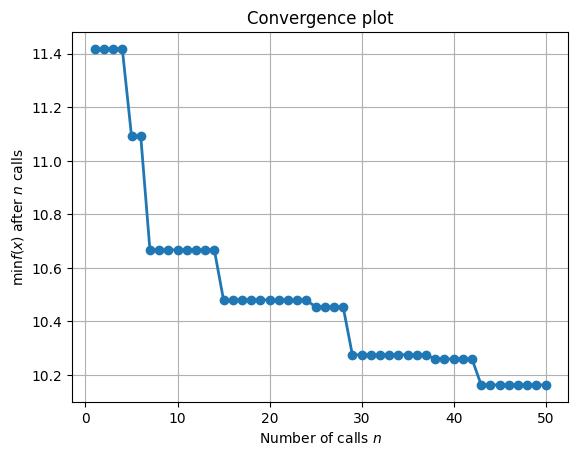
[31]:
_ = optimizer._plot_evaluations()
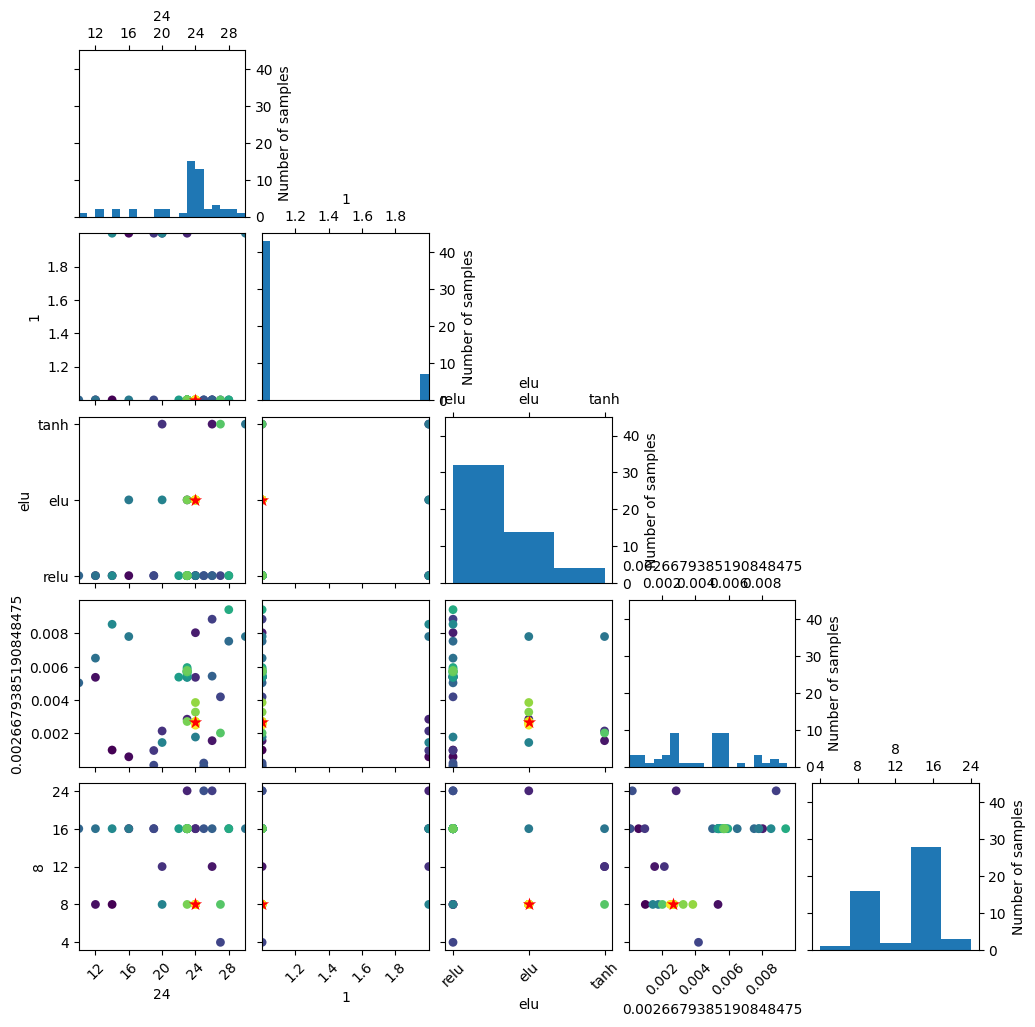
[34]:
_ = plot_objective(optimizer.gpmin_results)
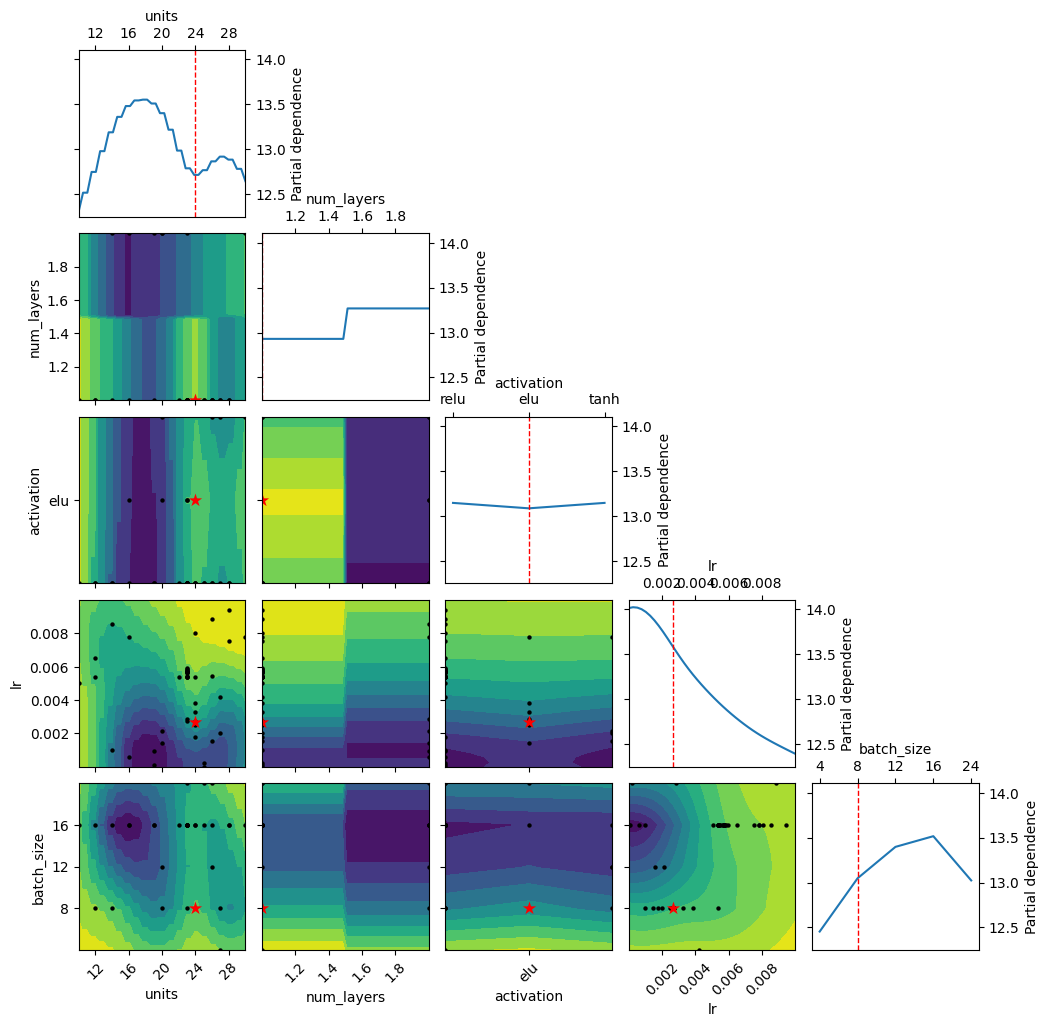
[42]:
_ = optimizer.plot_importance()

[36]:
_ = optimizer.plot_parallel_coords(figsize=(12, 8))
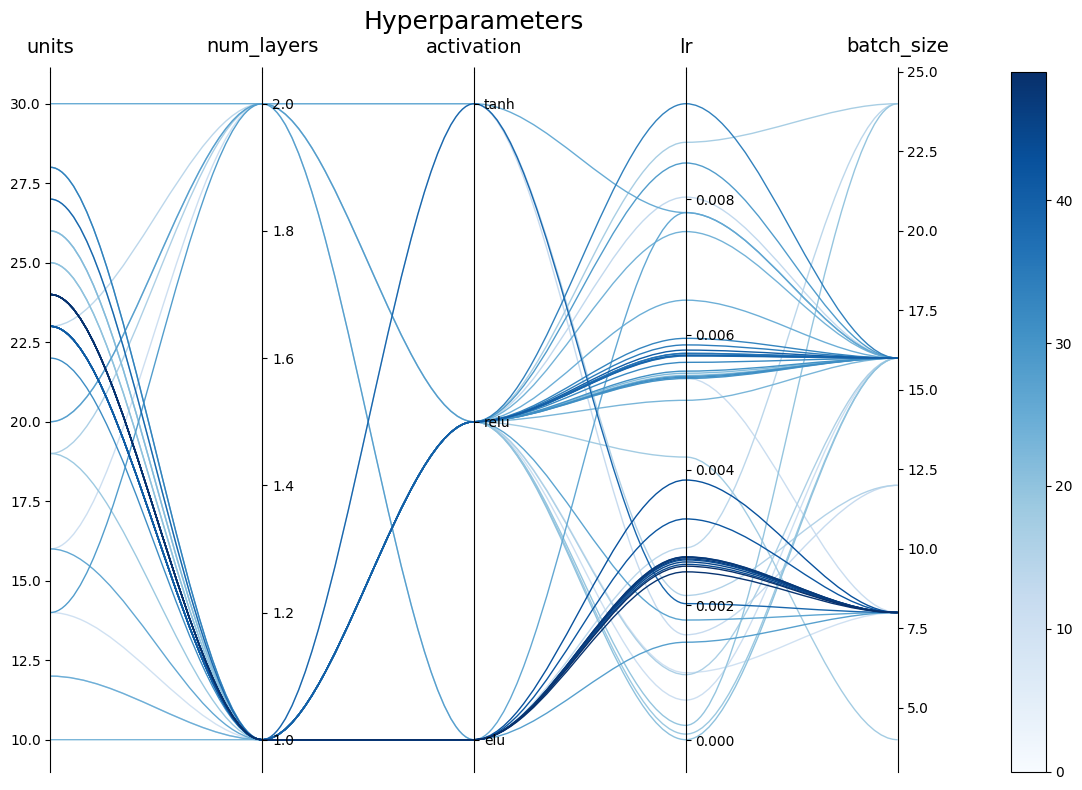
we can now again call the objective function with best/optimium parameters
6) train with best hyperparameters
[37]:
model = objective_fn(prefix=f"{PREFIX}{SEP}best",
return_model=True,
epochs=500,
verbosity=1,
**optimizer.best_paras())
building DL model for
regression problem using Model
Model: "model"
_________________________________________________________________
Layer (type) Output Shape Param #
=================================================================
input_1 (InputLayer) [(None, 11)] 0
Dense_0 (Dense) (None, 24) 288
Dropout (Dropout) (None, 24) 0
Flatten (Flatten) (None, 24) 0
Dense_out (Dense) (None, 1) 25
=================================================================
Total params: 313
Trainable params: 313
Non-trainable params: 0
_________________________________________________________________
assigning name input_1 to IteratorGetNext:0 with shape (None, 11)
assigning name input_1 to IteratorGetNext:0 with shape (None, 11)
assigning name input_1 to IteratorGetNext:0 with shape (None, 11)
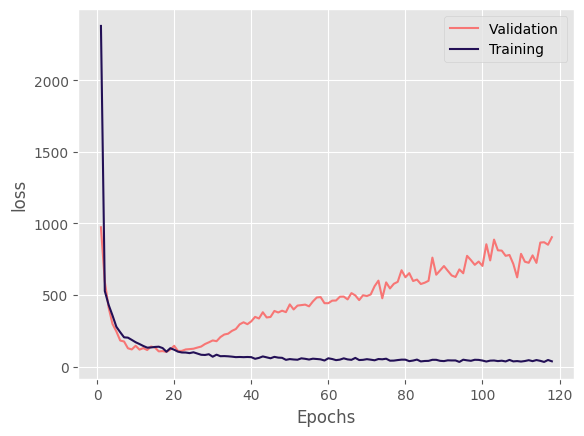
********** Successfully loaded weights from weights_018_103.28909.hdf5 file **********
assigning name input_1 to IteratorGetNext:0 with shape (None, 11)
8/8 [==============================] - 0s 718us/step
51 10.16 . Best was 10.16 at 42
[39]:
model.evaluate(x=TrainX, y=TrainY, metrics=['r2', 'nse', 'rmse'])
27/27 [==============================] - 0s 577us/step
[39]:
{'r2': 0.9207692548958313,
'nse': 0.9197818715253115,
'rmse': 8.373577108689467}
[40]:
model.evaluate(x=TestX, y=TestY, metrics=['r2', 'nse', 'rmse'])
12/12 [==============================] - 0s 636us/step
[40]:
{'r2': 0.8285461122661508, 'nse': 0.798126539273869, 'rmse': 15.51664265346751}
[43]:
optimizer.opt_path
[43]:
'results\\hpo_nn_20230207_181011'
[45]:
optimizer.save_results(results)
